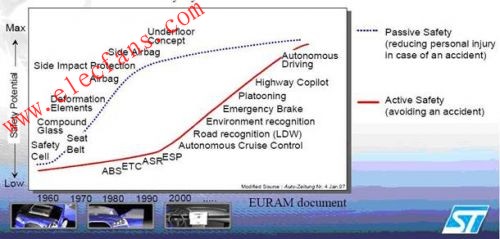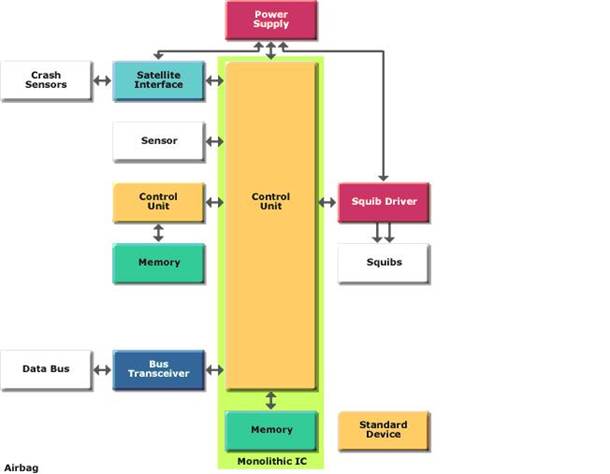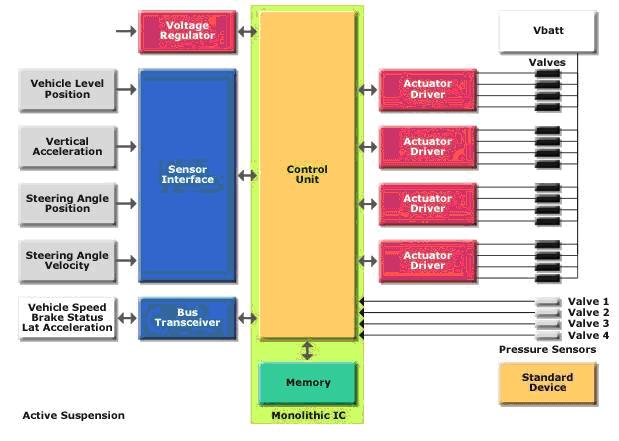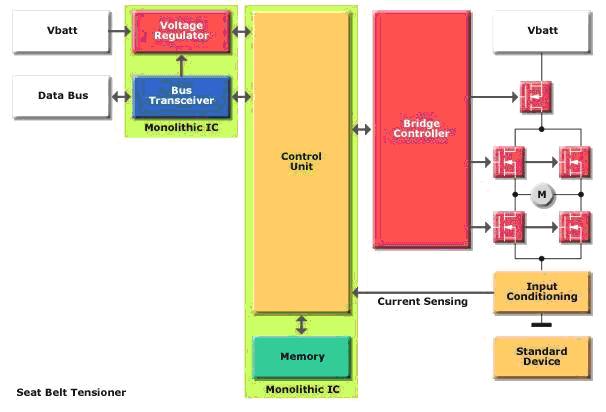Automotive active safety system
When discussing the differences between the styles of weapons defense systems in various countries, military experts often involve so-called passive systems and active systems. The design of automobile safety systems also reflects this idea everywhere.
The representative of the car passive safety system is the traditional bumper, safety belt, airbag, etc. The main purpose is to minimize the damage of the accident to the inside of the vehicle in the event of an accident. The opposite active safety system considers how to avoid such an accident.
Achieving active prevention and prevention of accidents requires various sensing and detection systems such as front-rear radar, night vision systems, infrared detection, ranging, CMOS/CCD image monitoring, and tire pressure automatic monitoring systems (TPMS). The main working principle is that the sensor obtains the required physical analog signal value from the outside, converts it into a digital signal and then analyzes it by a specific control unit, and makes effective decision-making and preventive measures.

Figure 1. Trend chart of car safety system from passive to active mode
Pre-collision system
Car traffic accidents are mostly caused by collisions between relatively high-speed moving objects, and most of the causes of collisions are related to violations of traffic rules, driver's visual obstruction and lack of concentration, such as drunk driving, fatigue driving, calling and chatting during driving. Wait. Many manufacturers are currently studying the Pre-Crash safety system as a response.
The pre-crash safety system can be divided into two types: the protection of the inside of the vehicle (driver and passengers) and the protection of the outsiders (the pedestrians and vehicles outside the vehicle), but the core of the safety guarantee is the active preparation and protection of the collision action. Measures. For the in-vehicle pre-crash safety system, when the relevant sensor or radar detects a potential collision hazard, it will first issue a warning to the driver inside the vehicle. If the warning is invalid, the automatic braking system will be activated before 0.6 seconds, according to the driver's braking force. Increase the auxiliary oil pressure to reduce the speed and avoid collision. At the same time, the pre-crash safety system also provides passive protection in the car, such as closing the window, adjusting the seat angle or the tightness of the seat belt to reduce the impact strength and make the airbag more effective. Outside the vehicle, the pre-crash safety system can also protect the safety of the object being hit by a series of measures. If a collision is unavoidable, the safety system will open an external airbag (such as a bumper, windshield, etc.) opposite the impact surface of the pedestrian to minimize the impact on the fragile and deadly parts of the head, chest, and waist.
2. ACC adaptive cruise control system
The so-called pre-crash system can only make a series of positive preparations before the collision occurs, instead of "preventing" the collision. The current rapid development of ACC (AdapTIve Cruise Control), that is, adaptive cruise control, can partially achieve collision prevention.
ACC is a speed control system for forward driving. Its main function is to control the safety distance between the vehicle and surrounding vehicles. It provides drivers with auxiliary information and advice for safe driving by means of multiple sensors and in-vehicle control systems arranged around the body, and promptly sends alerts to the driver when potential hazards are detected, even directly intervening in vehicle handling The system intervenes. However, in any case, the ACC only has partial intervention on the brakes, and the driver is still the core of the drive.
The key to ACC's speed and distance control is to lock the target vehicle in front and then calculate the speed and acceleration of the vehicle. The owner will set the reaction time for the ACC in advance. When the ACC is driving, the safety distance will be calculated according to the relative speed of the vehicle and the current distance, and the speed control in the next step will be judged; The control range of the ACC, the system switches to the pre-crash safety processing system.
3. Driving warning system
The driving warning system mainly uses sensors and imaging equipment such as CCD/CMOS as monitoring means. The built-in identification system determines whether the vehicle status and the driver's behavior are normal. If there is a problem, a warning signal is issued in time to avoid an accident. There are also driving warning systems that detect the alcohol concentration of the driver's exhaled gas and give appropriate warnings. In addition, the rear and side monitors can also be part of a driving warning system that eliminates the driver's visual dead angle and avoids common crashes when reversing.
The functions of the driving warning system mainly include Lane Departure Warning (LDW), driving danger warning, visual blind warning (or blind spot detection). Among them, the lane departure warning mainly warns the driver to enter the wrong lane, or prompts him to strike the direction light when changing lanes.
The driving warning system can provide effective auxiliary information for the driver's safe driving, but if the auxiliary information is not comprehensive enough, it will not play its due role. On the other hand, everything has its two sides. If the auxiliary information is too much or too complicated, it will not only be beneficial to safe driving, but sometimes it will make the driver tired of handling various auxiliary information and lack of concentration, which is easy to cause an accident.
In addition, the means by which auxiliary information is sent to the driver is also one of the issues worth studying. Screen display, instrument panel, voice, etc. are traditional means. At present, there is also a "body sense warning" mode, that is, the car sends information to the driver through the vibration pedal, seat, steering wheel, etc., or draws its attention.
4. Electronic stability program
Driving is a combination of people and vehicles. In addition to monitoring the behavior and status of the driver, the safety control system should also be able to effectively control the behavior of the vehicle. ESP (Electronic Stability Program) is an electronic stability program that integrates ABS (AnTI-lock Braking System) and TCS (TracTIon Control System). It is an active vehicle safety system that helps drivers keep their vehicles normal. State and behavior to prevent phenomena such as tire slippage and loss of control.
ABS is called the anti-dead lock brake system. When the car tires are deadlocked, ABS will quickly put the brakes on, preventing the vehicle from going wrong. The opposite TCS is called a tracking control system. When the tire is idling, the tire is regained grip by reducing the torque or the deadlock of the tire. By integrating the two, ESP applies different braking forces to each tire to correct the driving trajectory when the vehicle is skidding or understeer.
Sensor type and selection
Whether it is an auxiliary warning system such as a driving warning system or a system control system for electronic stability programs, its effective work is based on sufficient and reliable information and correct and rapid judgment in the background. The key to obtaining reliable information is the sensor and its reasonable distribution; the correct judgment comes from the fast response and reliable algorithm of the control system.
Vehicle sensors are located at different positions of the vehicle body according to their specific characteristics and applications, including radar, infrared, LIDAR (Light DetecTIng and Ranging), ultrasonic, acceleration sensor, CCD/CMOS imaging system.
The main sensors used in the pre-crash system are millimeter wave radar or laser radar. Among them, the price of millimeter wave radar is relatively high, mainly for the high-end car market; while the cost of laser radar is lower, only about 1/3 of the millimeter wave radar, targeting the low-priced car market. However, in terms of performance, the wavelength of the laser is short, which limits its application range, and is not conducive to the use of harsh environments such as rain and snow.
Infrared and image sensor-based monitor technology is mainly used for obstacle recognition and auxiliary field of view during driving. Infrared imaging can be further divided into far-infrared (FIR) technology for temperature detection and near-infrared (NIR) technology for night vision. FIR can detect organisms with temperature, which can display the heat radiated by the object as an image; NIR is mainly used for night vision and other poor line of sight, which can detect farther than the illumination of the lamp, but is also susceptible to the opposite light. The impact is mainly used for auxiliary road conditions such as night vision.
If you need to detect the outside of the car or even the inside of the car, you can use CCD or CMOS components as visual image sensors. At present, the application of CCD/CMOS is becoming more and more extensive. With advanced visual recognition algorithms, moving objects, road conditions and friction coefficients in the imaging range, traffic signals and signs on the roadside, and road lane separation lines can all be distinguished. Can become the driver's eyes.
CCD/CMOS also enables large dynamics to represent image detail in dim and high contrast environments by capturing high-sensitivity and low-sensitivity images and synthesizing them. In addition, the CCD/CMOS can be combined with the infrared or radar described above to form a hybrid sensor (Sensor Fusion). After the infrared generator illuminates the target object, the reflected infrared rays are absorbed by the CCD/CMOS, so that the road conditions can be recognized both day and night, providing the driver with powerful auxiliary vision.
System architecture analysis
The principles of various warning and strain systems such as pre-collision handling, safe speed/distance control of the vehicle safety system are very similar, that is, the ECU (Central Electronic Control Unit) accepts the relevant information of the external sensors and performs real-time evaluation through built-in algorithms. And decide the best contingency measures. Therefore, the design of automotive electronic systems is not much different from the general system design, but hard real-time and reliability are distinguishing features from other electronic control systems.
Take the Airbag control system as an example. The system consists mainly of airbags in front of the driver and passengers, a Satellite Sensor located outside the vehicle body, an acceleration sensor (G-Sensor) placed at the door, seat and roof, and usually 16 or 32. The MCU of the MCU is composed of several parts. When the body is hit, the impact sensor will immediately send a signal to the ECU, and the ECU will collect parameters such as collision strength, seat position, passenger weight, and seat belt to quickly evaluate and pass the electric blast drive in a very short time ( Squib Driver) Open the airbag to protect the safety of the people inside.

Figure 2 Airbag system architecture
As shown in Figure 3, the Active Suspension is also a relatively common security system in the car, which can greatly improve the handling of the vehicle. The active suspension system is mainly composed of a sensor, a shock absorber cylinder and a computer control system. The system can collect the car's speed, acceleration, load, steering degree, left and right G force and other data to adjust the suspension coefficient and the height of the chassis and the ground in real time.

Figure 3 Active suspension system architecture
More and more national laws and regulations have imposed requirements on the performance of Anti-lock Brake Systems (ABS), and the higher reliability requirements have increased the complexity and difficulty of ABS design. In the system shown in Figure 4, the main purpose of ABS is to prevent the dangerous situation of the vehicle stalling. When the control link finds that the emergency brake causes the speed to be too low, the brake will be quickly placed, giving the tire enough rolling space and a larger grip. Ground force to prevent the vehicle from going wrong. The key to this system is the measurement of tire speed.

Figure 4 ABS system architecture diagram
The system shown in Figure 5 is an Electric Power Assisted Steering (EPAS) system, referred to as the power steering wheel. Compared to conventional hydraulic steering wheels, EPAS uses electronic motors to provide driver with auxiliary control of wheel steering. EPAS generally obtains the position and torque of the steering wheel by the sensor, and then implements the auxiliary control of the electronic motor in combination with parameters such as vehicle speed, engine temperature, and battery power supply. EPAS has gradually entered the market, which not only reduces engine load, but also further improves fuel efficiency.

Figure 5 power steering system architecture
The Seat Belt Tensioner is also an advanced driving safety system that acts as a subsystem in the collision system. The pre-tensioned seat belt gives the driver and the passenger a larger shoulder space when the vehicle is running normally, so that it can enjoy the comfort of driving and riding; but at the moment of the accident, to protect the safety of the personnel and avoid the forward impact The resulting physical injury, the pre-tensioned seat belt can be quickly tightened, allowing the person to abut the seat, reducing the risk of collision with the object in front.

Figure 6 pre-tensioned seat belt system architecture
in conclusion
With the continuous advancement of electronic technology and control science, revolutionary changes have taken place in automotive electronic systems. The vehicle's safety protection system is also gradually upgraded to a passive safety system such as pre-crash control by a passive system such as a conventional seat belt or airbag. All of this is achieved by the support of multiple sensors and their control systems for performance such as driving, braking, engine control, speed control, and safety protection.
Waiting for your phone to charge is a thing of the past, Quick Charger pumps up to 18 W/30W/45W into your compatible smart phone or tablet, reducing charge time by up to 75% compared to conventional charger.
High quality ,competitive price and good servie, MLF welcome you. Please don't hesitate contact us if there is any question on the perfomance of switching power adapter .
Phone Charger Station,Iphone Charger Station,Charger Station
Meile Group Limited , http://www.hkmeile.com